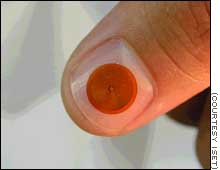|
Microchip Implants May Save Lives One Day
CNN--By Eleni Berger
(CNN) -- It sounds almost like a plot line from "Star Trek" -- a patient's life is saved thanks to a tiny microchip implanted in his body that lets a doctor detect a dangerous condition before it becomes critical. Such a scenario might be only a few years -- rather than a few centuries -- away. Researchers are testing an implantable microsensor that can send data to a hand-held receiver outside the body, alerting doctors to a potential medical crisis, without using any wires or batteries. They
call it a micro-electro mechanical systems device, or MEMS. The doctor
would be able to check the condition of a patient's heart, for example,
by holding the receiver near the patient -- a version of point and
click -- rather than putting him through a costly CAT scan or surgery.
The patient could even monitor his condition at home. "It's really the first time that we'll have a wireless way of getting information out of the body, so in that sense it really represents a leap forward," said Dr. Jay Yadav, director of vascular intervention at the Cleveland Clinic Foundation. Initial
data on the MEMS is being presented this week at the 14th annual International
Symposium on Endovascular Therapy in Miami Beach, Florida. Yadav developed the device with colleagues Mark Allen and David Stern of CardioMEMS, the Atlanta, Georgia-based company he co-founded. Allen, a professor of electrical engineering at Georgia Institute of Technology, originally invented the sensor for use in jet engines. The MEMS has been adapted to monitor blood pressure levels in the organs or blood clots of patients with heart failure or with abdominal aortic aneurysm, an abnormal widening of the aorta. If it works, it could provide doctors with an easier way to catch serious problems. "If we can reduce invasive procedures, hospital visits, we will have done (patients) a great service," Yadav says. Other doctors agree there's room for improvement in detecting the dangerous complications of these conditions. "The CardioMEMS could potentially revolutionize the follow-up of aneurysm," says Dr. Takao Ohki, chief of vascular surgery at Montefiore Hospital in New York. Current methods of treating abdominal aortic aneurysms can fail, he explains, causing a potentially deadly buildup of pressure in the blood vessel. The only way to detect these failures is to give the patient periodic CAT scans. But that method isn't foolproof. "Even if I do CAT scans every three to six months, some patients can rupture in between those CAT scans," Ohki says. "If they rupture, they can die. It's an emergency. It's a lethal condition." CAT scans are also expensive -- about $800 -- and they can't be done too frequently because they require radiation and an injection of IV contrast, Ohki adds. Furthermore, the CAT scan can only measure the size of the aneurysm, not the pressure -- which is the critical factor. "We
care about the pressure, but we only have the means to measure the
size and indirectly interpret the pressure," says Ohki. "It's
like a balloon. If the balloon is bigger, you think it's going to
pop, but what really matters is the pressure." Researchers envision implanting the MEMS sensor directly into blood clotted in the aneurysm, where it could monitor the pressure and transmit readings back to a doctor, or the patient if he or she is self-monitoring, as often as needed. The MEMS has successfully measured blood pressures in a healthy dog, a step Ohki calls a "milestone." Next, he will test the sensor in dogs with aneurysms to see how well it performs. Human trials of the device are also planned. If the sensor works, it could be adapted to monitor many conditions, Yadav says. It could be used in orthopedics to monitor pressure in casts that can cause nerve injury; it might be used in obstetrics to monitor contractions wirelessly; it might even replace the standard cuff doctors use to measure blood pressure. The device could eventually be modified to measure something other than pressure -- electrical signals, for instance, or glucose levels. And though a minor surgical procedure would be required to implant the chip, the actual monitoring would be "very user-friendly," Yadav says, requiring no special training. The work is still in the early stages, so researchers will have to watch for potential risk factors -- the chip dislodging, or the body having some kind of reaction to the plastic used to make the sensor. But they envision few complications. "If it stops working, the patient won't be any worse off than before," Yadav says. http://archives.cnn.com/2002/HEALTH/01/22/microchip.heart/
|
Uploaded: 11-10-05
